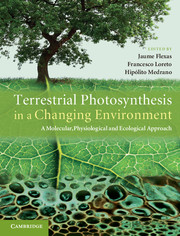 Terrestrial Photosynthesis in a Changing Environment
Terrestrial Photosynthesis in a Changing Environment Published online by Cambridge University Press: 05 March 2013
Introduction
Drought, salinity and flooding are among the most important abiotic stresses affecting plant growth and survival in large areas of the globe. They affect natural ecosystems, plantations and croplands, therefore posing large problems to nature conservation and to farmers and foresters. Drought is a major concern not only in the arid and semi-arid zones, but is also increasingly affecting temperate regions that are now subjected to occasional severe drought spells (IPCC2007 www.ipcc.ch). Alternatively, the same IPCC report indicates an increased occurrence of heavy precipitation and tropical cyclone activity, leading to more frequent flooding events. Salinity and flooding are often secondary stresses following years of incorrect and unsustainable irrigation practices, leading to increased soil salinity and the rise of phreatic soil-water. Flooding can have catastrophic impacts on the productivity of arable farmland, as most crops are intolerant to excess water (Voesenek et al., 2006). Moreover, drought and salt stresses are commonly accompanied by high temperatures and high irradiances that exacerbate the negative impact of each stress acting in isolation (Mittler, 2006).
The primary effects of drought and salinity are similar, as salinity in the soil reduces osmotic potential, making it harder for roots to extract water (Munns, 2002; Munns and Tester, 2008). On the contrary, under flooding water availability is high but O2 availability for root respiration is restricted owing to its slow diffusion in water, limiting root growth (Blom and Voesenek, 1996; Bailey Serres and Voesenek, 2008).
To save this book to your Kindle, first ensure no-reply@cambridge.org is added to your Approved Personal Document E-mail List under your Personal Document Settings on the Manage Your Content and Devices page of your Amazon account. Then enter the ‘name’ part of your Kindle email address below. Find out more about saving to your Kindle.
Note you can select to save to either the @free.kindle.com or @kindle.com variations. ‘@free.kindle.com’ emails are free but can only be saved to your device when it is connected to wi-fi. ‘@kindle.com’ emails can be delivered even when you are not connected to wi-fi, but note that service fees apply.
Find out more about the Kindle Personal Document Service.
To save content items to your account, please confirm that you agree to abide by our usage policies. If this is the first time you use this feature, you will be asked to authorise Cambridge Core to connect with your account. Find out more about saving content to Dropbox.
To save content items to your account, please confirm that you agree to abide by our usage policies. If this is the first time you use this feature, you will be asked to authorise Cambridge Core to connect with your account. Find out more about saving content to Google Drive.